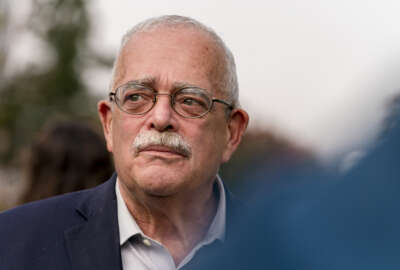
A conversation with Catherine Emerson, the Justice Department’s deputy assistant attorney general and chief human capital officer
A human resources officer at the Justice Department explained some of the current federal HR challenges, including ensuring employees have the technology they n...
Best listening experience is on Chrome, Firefox or Safari. Subscribe to Federal Drive’s daily audio interviews on Apple Podcasts or PodcastOne.
Federal employees on the frontlines of national security and law enforcement sometimes need a bit more care and attention than others. Catherine Emerson has long experience in this branch of human resources as the former chief human capital officer of the Homeland Security Department. She’s now deputy assistant attorney general and chief human capital officer at Justice. She talked to the Federal Drive with Tom Temin about some of the current federal HR challenges, including ensuring employees have the technology they need.
Interview transcript:
Catherine Emerson: We work closely with the CIO every day, we make sure that our folks have what they need, especially during the pandemic, we found that our employees needed top IT equipment, whether it was cell phones, monitors, we enhanced our video conferencing, for our attorneys who had to handle hearings and expert witness prep, we made sure that they had the equipment that they need, and we are constantly reevaluating that.
Tom Temin: Got it. And let’s back up for a minute because every federal agency has the issue of hiring people. And there’s turnover, there’s expansion of budgets for different missions that might come from what strikes Congress as important and it goes on and on. And the hiring process is often cited as an issue, the slowness, the relative slowness that takes. How do you go about that making sure that the hiring experience is such that when people are finally arriving as new employees, they feel good about it?
Catherine Emerson: Well, we have approximately 117,000 employees. So we do quite a bit of hiring. And we are constantly hiring. Right now, as you know, we are competing with the private sector and other agencies. So we are always on the lookout at for top talent, we have made sure that we bring our folks on board sometimes in a virtual environment where we do our orientations virtually now so that we can bring all folks from across the country into so they can meet and come together on the mission of the agency while going through the orientation process.
Tom Temin: But what about hiring? You know, it takes a long time from someone say, going to USAJobs.gov, if that’s their route in. Do you use hiring authorities? Do you use consistent with merit principals? But what do you do to try to speed it all up? So you’re more competitive with the private sector?
Catherine Emerson: Well, sometimes the private sector can hire faster, you are correct about that. But we try to do as best as we can, in terms of getting our positions posted. We have great HR specialists to do the best that they can within the federal regulations. We certainly make sure that those folks who need a security clearance have their paperwork filled out, and that they work with our specialists to get all the documentation, fingerprints, etc., to HR so that we can move that faster. But you’re right, sometimes the federal hiring does take longer than the private sector. And that’s something that we take into account in our hiring.
Tom Temin: In many cases, then it becomes a matter of selling the mission as much as selling the job?
Catherine Emerson: Oh, absolutely. In here at Department of Justice, we have a fabulous mission. And because of that, we have so many different types of jobs around the country, in fact around the world. But that also makes recruitment a considerable challenge. We have a lot of people that are attracted to our mission. So for many of our positions, we get a lot of applicants. Which is good. But we’re always searching for top talent.
Tom Temin: And then there is the issue of retention, which it changes, I guess the challenges of retention. Throughout an employee’s particular career, what might retain someone who’s new in their career or at a younger age of the age spectrum might be different than what it takes to retain someone mid-career or late career. How do you look at that? How do you think about that challenge? The retention challenge?
Catherine Emerson: It’s a challenge. But we do a fairly good job retaining our workforce. We provide our employees with the opportunity to do interesting work that connects to our mission. And we make sure that we reinforce this with our employees. One thing that we do regularly is we encourage our supervisors and managers to practice good performance management where they connect the employees duties, and they’re standard in elements with the mission of the agency. So it constantly gives the employees that connection back to the mission of what we do here at the department. Another thing that we do is we offer a lot of training for our employees. We encourage them to seek out training to work with their supervisors to identify in training what they’re interested in. We also encourage them if they’re interested in the leadership opportunities to seek out programs so that they can look at opportunities where they could be a leader, whether it’s being a team lead or supervisory, or actually later going into the Senior Executive Service. In fact, we have a department-wide program named the LEAP program, the leadership excellence and achievement program, which has been very successful over the last several years.
Tom Temin: Okay, and let’s talk about training for a minute in terms of how it’s delivered, because with people remote or teleworking, do you have opportunities for people to take training that’s doesn’t require them to travel or be in-person?
Catherine Emerson: Yes, we do. In fact, that’s a good point. You know, before the pandemic, we did a lot of training that was in-person when obviously, when the pandemic came, we had to immediately shift for those employees who weren’t at the workforce on the worksite. But let me back up for a minute over 70% of our employees showed up at the worksite every day during the pandemic, but that other 30%, yes, we did have to look at how we were giving our training. And we found that virtual training was very successful. We were able to train a number of employees across the country. And we found a lot of people participated in that even though they were extremely busy, and dealing with challenges, perhaps in their home environment. What we found was if we did training modules in anywhere from 60 to 90 minute increments, we got a lot of interest from our employees. So that was very exciting.
Tom Temin: Catherine Emerson, deputy attorney general and chief human capital officer at the Justice Department.
Copyright © 2024 Federal News Network. All rights reserved. This website is not intended for users located within the European Economic Area.
Tom Temin is host of the Federal Drive and has been providing insight on federal technology and management issues for more than 30 years.
Follow @tteminWFED
Related Stories

How federal agencies can best integrate competency-based assessments into hiring practices




